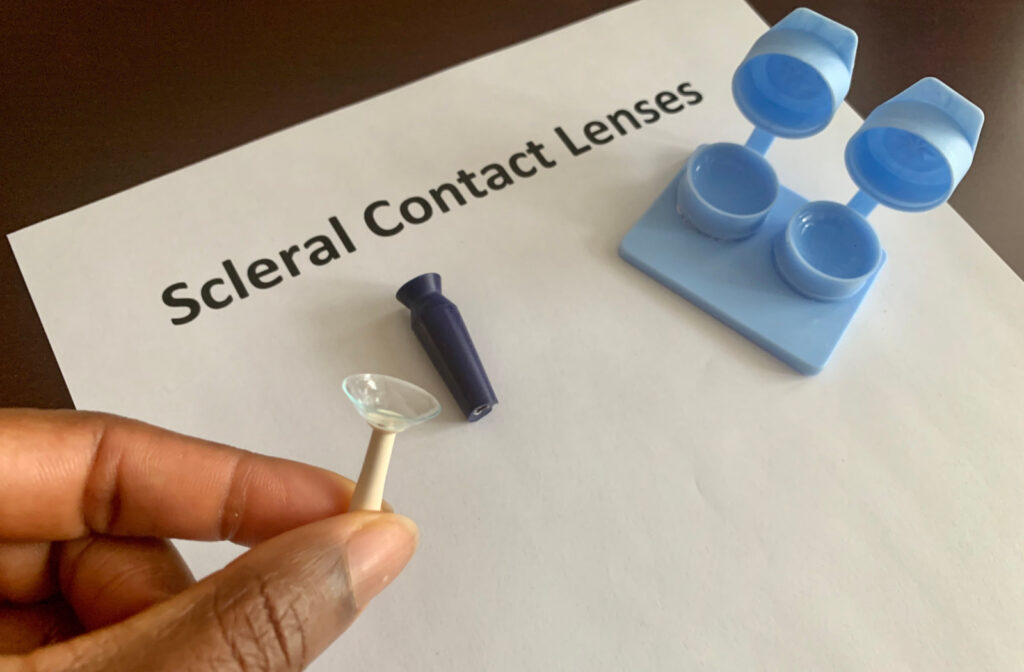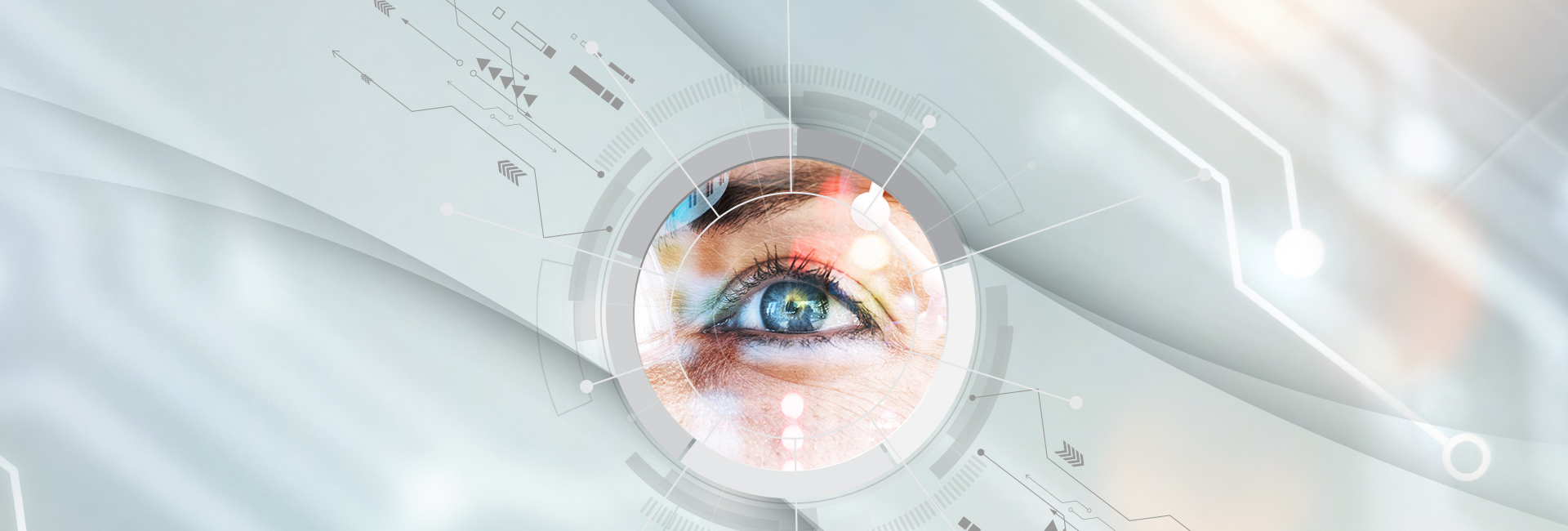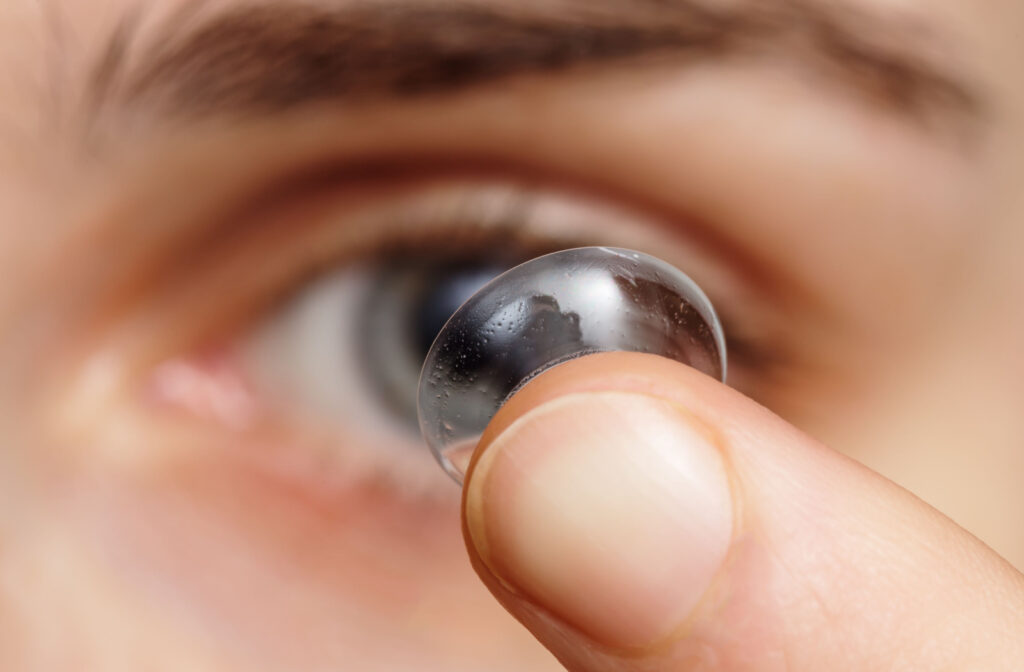When you think of contact lenses, you likely picture small, thin lenses sitting on the eye’s surface. However, there’s another type of contact lens that offers a range of benefits for people with certain eye conditions, including dry eyes.
Scleral lenses are larger, rigid lenses that rest on the whites of the eyes, called the sclera, offering improved comfort and stability compared to their smaller cousins. They can be an excellent choice for those seeking clearer vision but have been told they have hard-to-fit eyes.
How Do Scleral Lenses Work?
Scleral lenses are large, gas-permeable contact lenses that rest on the sclera (the white part of the eye) rather than the cornea (the eye’s clear, dome-shaped surface). Scleral lenses are often used in cases where traditional contact lenses fail to provide satisfactory results or are simply too uncomfortable.
One of the coolest features of scleral lenses occurs between the back of the lens and the eye. The large size of scleral lenses allows them to vault over the cornea. It’s similar to how eyeglasses don’t actually touch your eye to correct your vision. Scleral lenses do the same, but the distance is much smaller.
They require precise measurements, but a custom-fitted pair of scleral lenses can provide a level of visual acuity that may be difficult to achieve with traditional soft contact lenses.
What’s more, this space between the lens and the cornea fills with a refreshing liquid reservoir.
Who Can Benefit from Scleral Lenses?
Who may find bigger to be better? Scleral lenses offer a range of benefits thanks to their large size and relatively hard material, including:
- Sharper vision: Scleral lenses are a type of rigid-gas permeable (RGP) lens. Their firmer material, combined with the smooth optical surface created by the fluid reservoir, can provide crisper vision compared to soft contacts.
- Shielding the eye: Scleral lenses can be more than twice the size of conventional lenses! They can stretch across the eye to form a seal around the edges, keeping out dust, dirt, and other irritants you accumulate throughout the day.
- Improved stability: Because scleral lenses are larger than most other lenses, they’re less likely to accidentally fall out of your eye. This could make them a good choice for the more active-minded among us.
- Increased hydration: The signature fluid reservoir can bathe your eyes in moisture, helping your corneas stay hydrated and comfortable.
All these benefits and more can make scleral lenses a great option for people with eye conditions that make wearing contact difficult. You may be a good candidate for scleral lenses if you have:
- Keratoconus: A condition where the cornea becomes thin and cone-shaped, causing distorted vision.
- Astigmatism: An irregularly shaped cornea that can cause blurry or distorted vision.
- Severe dry eyes: A condition where the eyes do not produce enough tears or low-quality tears.
- Corneal damage or scarring: Scleral lenses can provide a protective layer and improve vision in cases of corneal damage or scarring.
An optometrist may recommend scleral lenses after surgery to assist the eye’s recovery. People who have tried traditional contact lenses and found them uncomfortable may also find relief with scleral lenses, as they provide a more comfortable and stable fit.

Scleral Lenses for Dry Eye
Contact lenses are a popular choice among patients for a reason. They offer improved peripheral vision, and you don’t have to worry about matching frames to your style. But even if someone wants the benefits of contact lenses, a condition such as dry eye can make wearing traditional lenses a literal pain. But that may not be the case with scleral lenses.
Dry eye occurs when your eyes don’t produce enough tears or when your tears are of poor quality and evaporate too quickly. Tears are essential for maintaining your eye health. They provide lubrication, nourishment, and protect your eyes against infections and harmful environments. Without your tears, you may experience dry eye symptoms, such as:
- Irritation and scratchiness
- Stinging or burning sensations
- Red eyes
- Light sensitivity
- Blurred vision
- Stringy mucus around the eyes
- Excessive tear production without relief
One of the primary ways that scleral lenses can help relieve dry eyes is by restoring moisture to the eye. This brings us back to that small amount of fluid trapped between the lens and the eye. This fluid provides a cushion that protects the cornea and helps to keep it moist.
The lens also acts as a barrier, protecting the eye from external irritants and allowing the natural tear film to remain intact. Meanwhile, their gas-permeable material allows oxygen to reach your eye. With scleral lenses, your eyes can stay hydrated, promoting overall eye health and reducing the discomfort associated with dry eyes.
Discover Dry Eye Relief Today
Scleral lenses can be a great option for people with a range of eye conditions, offering improved vision, comfort, and protection. Visit Eyesmate Vision Care and ask about whether scleral lenses may be a good fit for you!Whether you have dry eyes or eyes other doctors described as “hard to fit,” book your appointment today and discover the benefits scleral lenses can offer.



